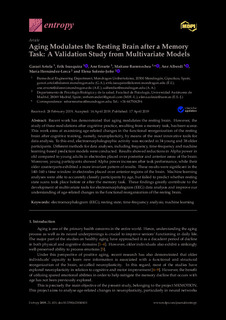| dc.rights.license | Attribution 4.0 International | * |
| dc.contributor.author | Artola, Garazi | |
| dc.contributor.author | Isusquiza Garcia, Erik | |
| dc.contributor.author | Errarte, Ane | |
| dc.contributor.author | Barrenechea, Maitane | |
| dc.contributor.author | Alberdi Aramendi, Ane | |
| dc.contributor.other | Hernández Lorca, María | |
| dc.contributor.other | Solesio Jofre, Elena | |
| dc.date.accessioned | 2020-03-27T09:47:40Z | |
| dc.date.available | 2020-03-27T09:47:40Z | |
| dc.date.issued | 2019 | |
| dc.identifier.issn | 1099-4300 | en |
| dc.identifier.other | https://katalogoa.mondragon.edu/janium-bin/janium_login_opac.pl?find&ficha_no=150904 | en |
| dc.identifier.uri | https://hdl.handle.net/20.500.11984/1606 | |
| dc.description.abstract | Recent work has demonstrated that aging modulates the resting brain. However, the study of these modulations after cognitive practice, resulting from a memory task, has been scarce. This work aims at examining age-related changes in the functional reorganization of the resting brain after cognitive training, namely, neuroplasticity, by means of the most innovative tools for data analysis. To this end, electroencephalographic activity was recorded in 34 young and 38 older participants. Different methods for data analyses, including frequency, time-frequency and machine learning-based prediction models were conducted. Results showed reductions in Alpha power in old compared to young adults in electrodes placed over posterior and anterior areas of the brain. Moreover, young participants showed Alpha power increases after task performance, while their older counterparts exhibited a more invariant pattern of results. These results were significant in the 140–160 s time window in electrodes placed over anterior regions of the brain. Machine learning analyses were able to accurately classify participants by age, but failed to predict whether resting state scans took place before or after the memory task. These findings greatly contribute to the development of multivariate tools for electroencephalogram (EEG) data analysis and improve our understanding of age-related changes in the functional reorganization of the resting brain. | en |
| dc.description.sponsorship | Unión Europea | es |
| dc.language.iso | eng | en |
| dc.publisher | MDPI AG | en |
| dc.rights | © by the authors | en |
| dc.rights.uri | http://creativecommons.org/licenses/by/4.0/ | * |
| dc.subject | electroencephalogram (EEG) | en |
| dc.subject | resting state | en |
| dc.subject | time-frequency analysis | en |
| dc.subject | machine learning | en |
| dc.title | Aging Modulates the Resting Brain after a Memory Task: A Validation Study from Multivariate Models | en |
| dc.type | http://purl.org/coar/resource_type/c_6501 | |
| dcterms.accessRights | http://purl.org/coar/access_right/c_abf2 | en |
| dcterms.source | Entropy | en |
| local.contributor.group | Teoría de la señal y comunicaciones | es |
| local.description.peerreviewed | true | en |
| local.identifier.doi | https://doi.org/10.3390/e21040411 | en |
| local.relation.projectID | info:eu-repo/grantAgreement/EC/H2020/660031/EU/Changing the course of cognitive decline in normal aging with positive emotions by training brain plasticity/MEMOTION | en |
| local.rights.publicationfee | APC | en |
| local.rights.publicationfeeamount | 1470 EUR | en |
| local.contributor.otherinstitution | https://ror.org/01cby8j38 | es |
| local.source.details | Vol. 21. N. 4. N. artículo 411, 2019 | eu_ES |
| oaire.format.mimetype | application/pdf | |
| oaire.file | $DSPACE\assetstore | |
| oaire.resourceType | http://purl.org/coar/resource_type/c_6501 | en |
| oaire.version | http://purl.org/coar/version/c_970fb48d4fbd8a85 | en |








